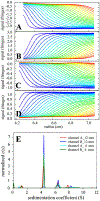Efficient data acquisition with three-channel centerpieces in sedimentation velocity
- PMID: 31493371
- PMCID: PMC6768728
- DOI: 10.1016/j.ab.2019.113414
Efficient data acquisition with three-channel centerpieces in sedimentation velocity
Abstract
Three-channel 3D printed centerpieces with two sample sectors next to a joint solvent reference sector were recently described as a strategy to double the throughput of sedimentation velocity analytical ultracentrifugation experiments [Anal. Chem. 91 (2019) 5866-5873]. They are compatible with Rayleigh interference optical detection in commercial analytical ultracentrifuges, but require the rotor angles of data acquisition to be repeatedly adjusted during the experiment to record data from the two sample sectors. Here we present an approach to automate this data acquisition mode through the use of a secondary, general-purpose automation software, and an accompanying data pre-processing software for scan sorting.
Keywords: 3D printing; Analytical ultracentrifugation; Laboratory automation; Sedimentation velocity.
Published by Elsevier Inc.
Figures


Similar articles
-
Enhanced Sample Handling for Analytical Ultracentrifugation with 3D-Printed Centerpieces.Anal Chem. 2019 May 7;91(9):5866-5873. doi: 10.1021/acs.analchem.9b00202. Epub 2019 Apr 15. Anal Chem. 2019. PMID: 30933465 Free PMC article.
-
3D-Printing for Analytical Ultracentrifugation.PLoS One. 2016 Aug 15;11(8):e0155201. doi: 10.1371/journal.pone.0155201. eCollection 2016. PLoS One. 2016. PMID: 27525659 Free PMC article.
-
A modified experimental setup for sedimentation equilibrium experiments with gels. Part 2: Technical developments.Anal Biochem. 1994 Jun;219(2):321-34. doi: 10.1006/abio.1994.1272. Anal Biochem. 1994. PMID: 8080089
-
Analytical ultracentrifugation for the study of protein association and assembly.Curr Opin Chem Biol. 2006 Oct;10(5):430-6. doi: 10.1016/j.cbpa.2006.08.017. Epub 2006 Aug 28. Curr Opin Chem Biol. 2006. PMID: 16935549 Review.
-
3D Printing for veterinary anatomy: An overview.Anat Histol Embryol. 2019 Nov;48(6):609-620. doi: 10.1111/ahe.12502. Anat Histol Embryol. 2019. PMID: 31702827 Review.
Cited by
-
An automated interface for sedimentation velocity analysis in SEDFIT.PLoS Comput Biol. 2023 Sep 5;19(9):e1011454. doi: 10.1371/journal.pcbi.1011454. eCollection 2023 Sep. PLoS Comput Biol. 2023. PMID: 37669309 Free PMC article.
-
Resuspending samples in analytical ultracentrifugation.Anal Biochem. 2020 Sep 1;604:113771. doi: 10.1016/j.ab.2020.113771. Epub 2020 May 11. Anal Biochem. 2020. PMID: 32407733 Free PMC article.
-
An automated interface for sedimentation velocity analysis in SEDFIT.bioRxiv [Preprint]. 2023 May 14:2023.05.14.540690. doi: 10.1101/2023.05.14.540690. bioRxiv. 2023. Update in: PLoS Comput Biol. 2023 Sep 5;19(9):e1011454. doi: 10.1371/journal.pcbi.1011454. PMID: 37425873 Free PMC article. Updated. Preprint.
-
Open-source autosampler for elemental and isotopic analyses of solids.HardwareX. 2020 Jul 10;8:e00123. doi: 10.1016/j.ohx.2020.e00123. eCollection 2020 Oct. HardwareX. 2020. PMID: 35498251 Free PMC article.
-
Analytical Ultracentrifugation (AUC): An Overview of the Application of Fluorescence and Absorbance AUC to the Study of Biological Macromolecules.Curr Protoc Mol Biol. 2020 Dec;133(1):e131. doi: 10.1002/cpmb.131. Curr Protoc Mol Biol. 2020. PMID: 33351266 Free PMC article.
References
-
- Svedberg T, Rinde H, The determination of the distribution of size of particles in disperse systems, J. Am. Chem. Soc 45 (1923) 943–954. doi:10.1021/ja01657a012. - DOI
-
- Svedberg T, Rinde H, The ultra-centrifuge, a new instrument for the determination of size and distribution of size of particle in amicroscopic colloids, J. Am. Chem. Soc 46 (1924) 2677–2693. doi:10.1021/ja01677a011. - DOI
-
- Schuck P, Zhao H, Brautigam CA, Ghirlando R, Basic Principles of Analytical Ultracentrifugation, CRC Press, Boca Raton, FL, 2015.
Publication types
MeSH terms
Grants and funding
LinkOut - more resources
Full Text Sources

